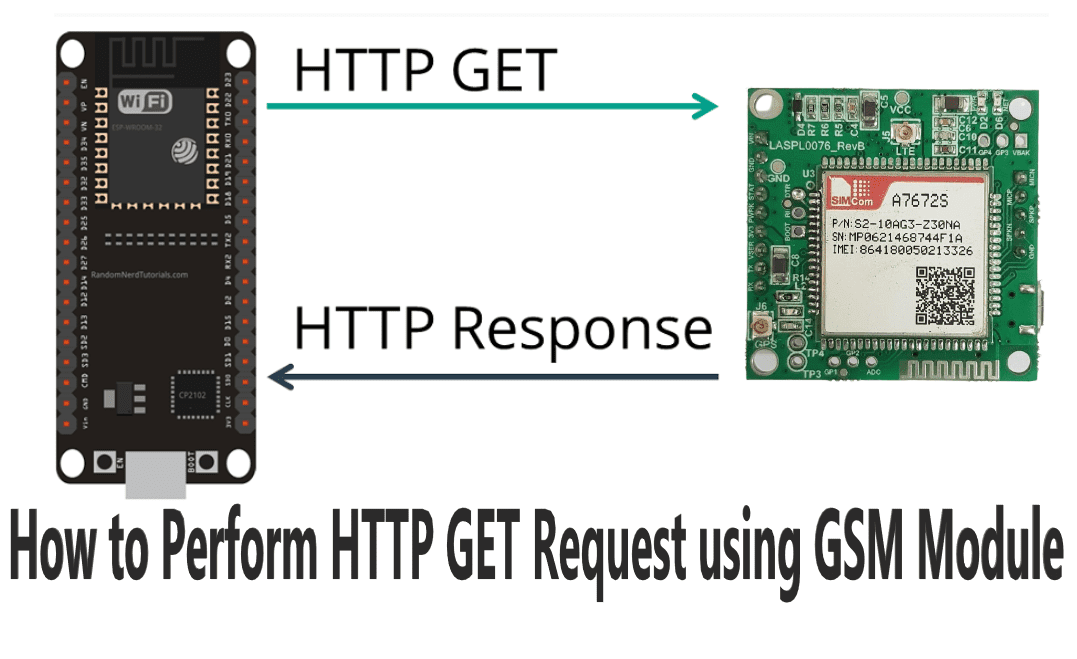
With the use of GSM data can be sent to a web server via HTTP using POST/GET. This allows us to connect any Embedded or IOT applications and other sensors to the Internet at a reasonable price if Ethernet, LoRa or WiFi is not available at the site. In This article we will learn how to send a HTTP request with the A7672S using AT commands.
The AS7672 GSM module is a powerful tool that enables seamless integration of Global System for Mobile Communications (GSM) technology into electronic projects. In this blog post, we'll deep dive into the step-by-step process of performing HTTP GET requests using the A7672S GSM module, unlocking a world of possibilities for your IoT (Internet of Things) applications.
Project Overview
In this project the GSM module i.e A7672S is interfaced with Microcontroller, and the server connection is established by the AT commands passed by microcontroller to the GSM module. By performing GET requests we can get the information stored on our server and also download files, or images, etc.
Hardware Requirements
SIM7672S is the LTE Cat 1 module which supports wireless communication modes of LTE-FDD/GSM/GPRS/EDGE.It supports maximum 10 Mbps downlink rate and 5 Mbps uplink rate.
Meanwhile A7672S integrates abundant industrial standard interfaces with powerful expansibility, such as UART, USB, I2C and GPIO, which makes it perfectly suitable for main IOT applications such as telematics, surveillance devices, industrial routers, and remote diagnostics etc.
Hardware Connection
Connect the A7672S to ESP32 via UART pins i.e RX pin to TX and TX pin to Rx.
Connect a proper power supply to ensure the module turns on.
After successfully making the connections we will code the ESP32 so the whole process gets automated.
Copy the following code and paste in Arduino IDE and select ESP32 Dev Module, further compile the code and upload it:
1. Initialize the GSM Module:
Write a simple Arduino sketch to initialize the GSM module. This includes configuring the necessary parameters such as baud rate, communication pins, and other settings
#include <SoftwareSerial.h>
SoftwareSerial gsmSerial(7, 8); // RX, TX
void setup()
{ Serial.begin(9600);
gsmSerial.begin(9600); // Initialize the GSM module
gsmSerial.println("AT");
delay(1000);
while(gsmSerial.available())
{ Serial.write(gsmSerial.read()); } }
2. Configure Internet Settings:
Configure the APN (Access Point Name) settings for your cellular network provider. This information is crucial for establishing an internet connection through the GSM module.
void setup() {
// Set the APN for your cellular network provider gsmSerial.println("AT+CGDCONT=1,\"IP\",\"your_apn\"");
delay(1000);
while(gsmSerial.available())
{ Serial.write(gsmSerial.read()); } }
//Replace "your_apn" with the correct APN for your cellular network provider.
3. Perform HTTP GET Request:
Now, it's time to send an HTTP GET request. This example sends a request to a server with an endpoint "/data" and displays the response.
void setup()
{
// Perform HTTP GET request
gsmSerial.println("AT+HTTPINIT");
delay(1000);
while(gsmSerial.available())
{ Serial.write(gsmSerial.read()); } gsmSerial.println("AT+HTTPPARA=\"URL\",\"http://your_server.com/data\"");
delay(1000);
while(gsmSerial.available())
{ Serial.write(gsmSerial.read()); }
gsmSerial.println("AT+HTTPACTION=0");
delay(10000); // Adjust delay based on server response time
while(gsmSerial.available())
{ Serial.write(gsmSerial.read()); }
gsmSerial.println("AT+HTTPTERM");
delay(1000);
while(gsmSerial.available())
{ Serial.write(gsmSerial.read()); }
}
//Replace "http://your_server.com/data" with the actual URL you want to request.
After Successfully compiling and Uploading you will get the following response on Serial Monitor for the performed GET requests.
Conclusion
By following these steps, you can successfully perform HTTP GET requests using the A7672S GSM module. This opens up opportunities for creating IoT devices, remote monitoring systems, and much more. Experiment with different commands and explore the capabilities of the GSM module to your specific project requirements.

